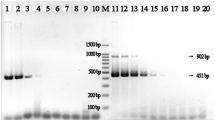Abstract
A semi-nested PCR method for the specific and individual amplification of type II phaC1 and phaC2 subgenomic fragments containing the catalytically important lipase box-like sequence and the phosphopantetheine binding site was developed. Direct sequencing of these ΔphaC1 and ΔphaC2 fragments is possible, thus greatly facilitating the characterization of these genes. The method was used to show that three strains of Pseudomonas oleovorans harbor different pha loci, while five strains of P. corrugata contain identical ΔphaC1 and ΔphaC2 subgenomic fragments.
Similar content being viewed by others
References
Altschul SF, Madden TL, Schäffer AA, Zhang J, Zhang Z, Miller W, Lipman DJ (1997) Gapped BLAST and PSI-BLAST: a new generation of protein database search programs. Nucl. Acids Res. 25: 3389-3402.
Anderson AJ, Dawes EA (1990) Occurrence, metabolism, metabolic role, and industrial uses of bacterial polyhydroxyalkanoates. Microbiol. Rev. 54: 450-472.
Brandl H, Gross RA, Lenz RW, Fuller RC (1988) Pseudomonas oleovorans as a source of poly(β-hydroxyalkanoates) for potential applications as biodegradable polyesters. Appl. Environ. Microbiol. 54: 1977-1982.
Catara V, Gardan L, Lopez MM (1997) Phenotypic heterogeneity of Pseudomonas corrugata strains from southern Italy. J. Appl. Microbiol. 83: 576-586.
De Smet MJ, Eggink G, Witholt B, Kingma J, Wynberg H (1983) Characterization of intracellular inclusions formed by Pseudomonas oleovovans during growth on octane. J. Bacteriol. 154: 870-878.
Gerngross UT, Snell KD, Peoples OP, Sinskey AJ, Csuhai E, Masamune S, Stubbe J (1994) Overexpression and purification of the soluble polyhydroxyalkanoate synthase from Alcaligenes autrophus: evidence for a required posttranslational modification for catalytic activity. Biochemistry 33: 9311-9320.
Huisman GW, Wonink E, Meima R, Kazemier B, Terpstra P, Witholt B (1991) Metabolism of poly(3-hydroxyalkanoates) (PHAs) by Pseudomonas oleovorans: identification and sequences of genes and function of the encoded proteins in the synthesis and degradation of PHA. J. Biol. Chem. 266: 2191-2198.
Sambrook J, Fritsch EF, Maniatis T (1989) Molecular Cloning: A Laboratory Manual, 2nd edn. Cold Spring Harbor, NY: Cold Spring Harbor Laboratory Press.
Sheu D-S, Wang Y-T, Lee C-Y (2000) Rapid detection of polyhydroxyalkanoate-accumulating bacteria isolated from the environment by colony PCR. Microbiology 146: 2019-2025.
Siverio F, Carbonell EA, Garcia F, Lopez MM (1996) Characteristics of the whole cell fatty acid profiles of Pseudomonas corrugata. Eur. J. Plant Pathol. 102: 519-526.
Solaiman DKY (2000) PCR cloning of Pseudomonas resinovorans polyhydroxyalkanoate biosynthesis genes and expression in Escherichia coli. Biotechnol. Lett. 22: 789-794.
Solaiman DKY, Ashby RD, Foglia TA (2000) Rapid and specific identification of medium-chain-length polyhydroxyalkanoate synthase gene by polymerase chain reaction. Appl. Microbiol. Biotechnol. 53: 690-694.
Sutra L, Siverio F, Lopez MM, Hunault G, Bollet C, Gardan L (1997) Taxonomy of Pseudomonas strains isolated from tomato pith necrosis: emended description of Pseudomonas corrugata and proposal of three unnamed fluorescent Pseudomonas genomospecies. Int. J. Syst. Bacteriol. 47: 1020-1033.
Tatiana AT, Madden TL (1999) Blast 2 sequences-a new tool for comparing protein and nucleotide sequences. FEMS Microbiol. Lett. 174: 247-250.
Timm A, Steinbüchel A (1992) Cloning and molecular analysis of the poly(3-hydroxyalkanoic acid) gene locus of Pseudomonas aeruginosa PAO1. Eur. J. Biochem. 209: 15-30.
van Beilen JB, Panke S, Lucchini S, Franchini AG, Rothlisberger M, Witholt B (2001) Analysis of Pseudomonas putida alkanedegradation gene clusters and flanking insertion sequences: evolution and regulation of the alk genes. Microbiology 147: 1621-1630.
Zhang G, Hang X, Green P, Ho K-P, Chen G-Q (2001) PCR cloning of type II polyhydroxyalkanoate biosynthesis genes from two Pseudomonas strains. FEMS Microbiol. Lett. 198: 165-170.
Author information
Authors and Affiliations
Rights and permissions
About this article
Cite this article
Solaiman, D.K. Polymerase-chain-reaction-based detection of individual polyhydroxyalkanoate synthase phaC1 and phaC2 genes*,** . Biotechnology Letters 24, 245–250 (2002). https://doi.org/10.1023/A:1014017609866
Issue Date:
DOI: https://doi.org/10.1023/A:1014017609866




